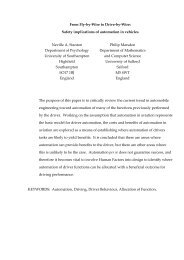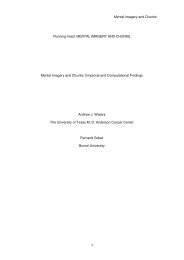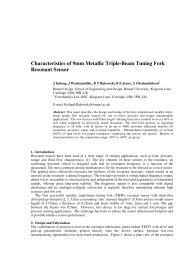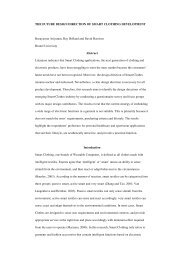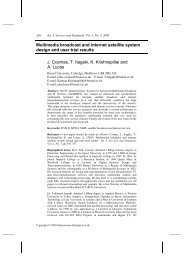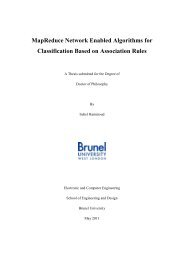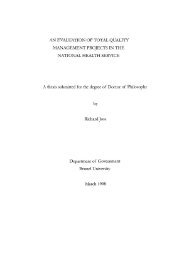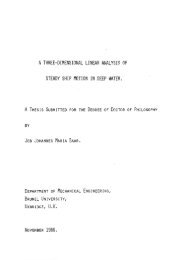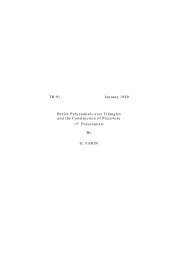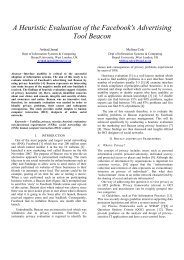insights from the british monarchy - BURA - Brunel University
insights from the british monarchy - BURA - Brunel University
insights from the british monarchy - BURA - Brunel University
You also want an ePaper? Increase the reach of your titles
YUMPU automatically turns print PDFs into web optimized ePapers that Google loves.
24<br />
Recently, <strong>the</strong> British Crown appears to have recognised <strong>the</strong> imperative of<br />
seeing <strong>the</strong> institution through <strong>the</strong> eyes of <strong>the</strong> public. The statement made by<br />
Queen Elizabeth II in 1997 on <strong>the</strong> occasion of her 50 th wedding anniversary is,<br />
perhaps, one of <strong>the</strong> most remarkable of her reign:<br />
‚Despite <strong>the</strong> huge constitutional difference between a hereditary <strong>monarchy</strong> and an<br />
elected government, in reality <strong>the</strong> gulf is not so wide. They are complementary<br />
institutions, each with its own role to play. Each, in its different way, exists only with<br />
<strong>the</strong> support and consent of <strong>the</strong> people. That consent, of <strong>the</strong> lack of it, is expressed for<br />
you, Prime Minister, through <strong>the</strong> ballot box. It is a tough, even brutal, system but at<br />
least <strong>the</strong> message is clear for all to read. For us, a Royal Family, however, <strong>the</strong> message<br />
is often harder to read, obscured as it ca be by deference, rhetoric or <strong>the</strong> conflicting<br />
attitudes of public opinion. But read it we must.‛ (Cited in Hames and Leonard<br />
1988)<br />
Normative advice regarding <strong>the</strong> management of <strong>the</strong> Crown as a Corporate<br />
Brand:<br />
(a) A distinction needs to be made between <strong>the</strong> legal ownership of <strong>the</strong> <strong>monarchy</strong> as a<br />
corporate brand (by <strong>the</strong> dynasty and by <strong>the</strong> apparatus of <strong>the</strong> nation state) and its<br />
emotional ownership by <strong>the</strong> general public. The Crown’s corporate brand power is<br />
dependent on <strong>the</strong> latter and <strong>the</strong>re are important obligations that flow <strong>from</strong> this.<br />
(b) Customs and traditions need to be considered so that <strong>the</strong>y remain meaningful to<br />
<strong>the</strong> crown’s brand community. This may mean that some traditions are ended,<br />
altered, re-instated or although retained are reinterpreted by key stakeholders.<br />
Theoretical Insight:<br />
This critical incident supports <strong>the</strong> <strong>the</strong>oretical contributions of Lawer and Knox who state<br />
that, in part, an effective corporate brand requires customer involvement (<strong>the</strong> public in this<br />
case) and fostering knowledge-creating customer partnerships. Balmer (2008) in his<br />
corporate branding mix includes relevance and responsiveness as key corporate brand<br />
management determinants; both were very apparent in <strong>the</strong> above critical incident. The<br />
‚Latin School of Thought‛ in marketing (Badot and Cova 1995) is also salient in terms of<br />
our comprehension of <strong>the</strong> Crown as a brand since it argues that marketing management<br />
should, in part, be focused on <strong>the</strong> creation of social ties between individuals via an<br />
individual’s membership of a corporate brand community. The British Monarchy very<br />
much appears to fulfill this role.<br />
Managing <strong>the</strong> British Monarchy as a Corporate Brand: Normative Insights<br />
A principal aim of this article was to provide some normative <strong>insights</strong> in<br />
terms of managing <strong>the</strong> <strong>monarchy</strong> as a corporate brand. The six critical<br />
incidents examined in <strong>the</strong> case history revealed <strong>the</strong> significance of continuity<br />
(maintaining heritage and symbolism); visibility (having a high public profile);<br />
strategy (anticipating and enacting change); sensitivity (rapid response to crises);<br />
24



